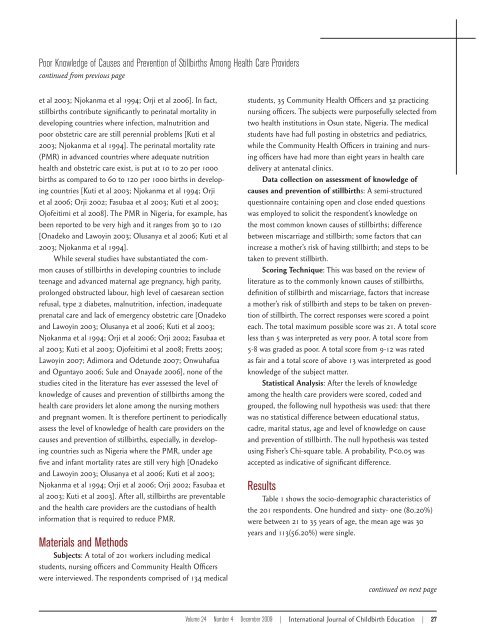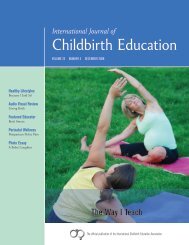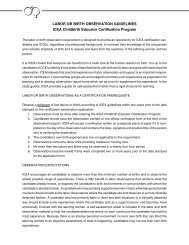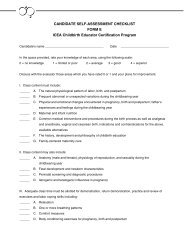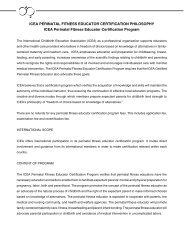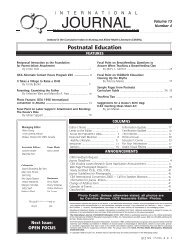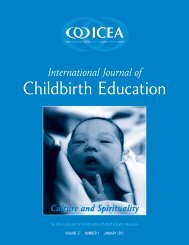Birth Day - International Childbirth Education Association
Birth Day - International Childbirth Education Association
Birth Day - International Childbirth Education Association
Create successful ePaper yourself
Turn your PDF publications into a flip-book with our unique Google optimized e-Paper software.
Poor Knowledge of Causes and Prevention of Stillbirths Among Health Care Providers<br />
continued from previous page<br />
et al 2003; Njokanma et al 1994; Orji et al 2006]. In fact,<br />
stillbirths contribute significantly to perinatal mortality in<br />
developing countries where infection, malnutrition and<br />
poor obstetric care are still perennial problems [Kuti et al<br />
2003; Njokanma et al 1994]. The perinatal mortality rate<br />
(PMR) in advanced countries where adequate nutrition<br />
health and obstetric care exist, is put at 10 to 20 per 1000<br />
births as compared to 60 to 120 per 1000 births in developing<br />
countries [Kuti et al 2003; Njokanma et al 1994; Orji<br />
et al 2006; Orji 2002; Fasubaa et al 2003; Kuti et al 2003;<br />
Ojofeitimi et al 2008]. The PMR in Nigeria, for example, has<br />
been reported to be very high and it ranges from 30 to 120<br />
[Onadeko and Lawoyin 2003; Olusanya et al 2006; Kuti et al<br />
2003; Njokanma et al 1994].<br />
While several studies have substantiated the common<br />
causes of stillbirths in developing countries to include<br />
teenage and advanced maternal age pregnancy, high parity,<br />
prolonged obstructed labour, high level of caesarean section<br />
refusal, type 2 diabetes, malnutrition, infection, inadequate<br />
prenatal care and lack of emergency obstetric care [Onadeko<br />
and Lawoyin 2003; Olusanya et al 2006; Kuti et al 2003;<br />
Njokanma et al 1994; Orji et al 2006; Orji 2002; Fasubaa et<br />
al 2003; Kuti et al 2003; Ojofeitimi et al 2008; Fretts 2005;<br />
Lawoyin 2007; Adimora and Odetunde 2007; Onwuhafua<br />
and Oguntayo 2006; Sule and Onayade 2006], none of the<br />
studies cited in the literature has ever assessed the level of<br />
knowledge of causes and prevention of stillbirths among the<br />
health care providers let alone among the nursing mothers<br />
and pregnant women. It is therefore pertinent to periodically<br />
assess the level of knowledge of health care providers on the<br />
causes and prevention of stillbirths, especially, in developing<br />
countries such as Nigeria where the PMR, under age<br />
five and infant mortality rates are still very high [Onadeko<br />
and Lawoyin 2003; Olusanya et al 2006; Kuti et al 2003;<br />
Njokanma et al 1994; Orji et al 2006; Orji 2002; Fasubaa et<br />
al 2003; Kuti et al 2003]. After all, stillbirths are preventable<br />
and the health care providers are the custodians of health<br />
information that is required to reduce PMR.<br />
Materials and Methods<br />
Subjects: A total of 201 workers including medical<br />
students, nursing officers and Community Health Officers<br />
were interviewed. The respondents comprised of 134 medical<br />
students, 35 Community Health Officers and 32 practicing<br />
nursing officers. The subjects were purposefully selected from<br />
two health institutions in Osun state, Nigeria. The medical<br />
students have had full posting in obstetrics and pediatrics,<br />
while the Community Health Officers in training and nursing<br />
officers have had more than eight years in health care<br />
delivery at antenatal clinics.<br />
Data collection on assessment of knowledge of<br />
causes and prevention of stillbirths: A semi-structured<br />
questionnaire containing open and close ended questions<br />
was employed to solicit the respondent’s knowledge on<br />
the most common known causes of stillbirths; difference<br />
between miscarriage and stillbirth; some factors that can<br />
increase a mother’s risk of having stillbirth; and steps to be<br />
taken to prevent stillbirth.<br />
Scoring Technique: This was based on the review of<br />
literature as to the commonly known causes of stillbirths,<br />
definition of stillbirth and miscarriage, factors that increase<br />
a mother’s risk of stillbirth and steps to be taken on prevention<br />
of stillbirth. The correct responses were scored a point<br />
each. The total maximum possible score was 21. A total score<br />
less than 5 was interpreted as very poor. A total score from<br />
5-8 was graded as poor. A total score from 9-12 was rated<br />
as fair and a total score of above 13 was interpreted as good<br />
knowledge of the subject matter.<br />
Statistical Analysis: After the levels of knowledge<br />
among the health care providers were scored, coded and<br />
grouped, the following null hypothesis was used: that there<br />
was no statistical difference between educational status,<br />
cadre, marital status, age and level of knowledge on cause<br />
and prevention of stillbirth. The null hypothesis was tested<br />
using Fisher’s Chi-square table. A probability, P


